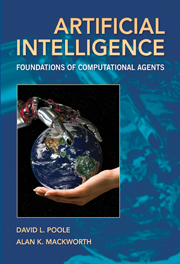Book contents
- Frontmatter
- Contents
- Preface
- I Agents in the World: What Are Agents and How Can They Be Built?
- II Representing and Reasoning
- III Learning and Planning
- IV Reasoning About Individuals and Relations
- 12 Individuals and Relations
- 13 Ontologies and Knowledge-Based Systems
- 14 Relational Planning, Learning, and Probabilistic Reasoning
- V The Big Picture
- A Mathematical Preliminaries and Notation
- Bibliography
- Index
12 - Individuals and Relations
from IV - Reasoning About Individuals and Relations
- Frontmatter
- Contents
- Preface
- I Agents in the World: What Are Agents and How Can They Be Built?
- II Representing and Reasoning
- III Learning and Planning
- IV Reasoning About Individuals and Relations
- 12 Individuals and Relations
- 13 Ontologies and Knowledge-Based Systems
- 14 Relational Planning, Learning, and Probabilistic Reasoning
- V The Big Picture
- A Mathematical Preliminaries and Notation
- Bibliography
- Index
Summary
There is a real world with real structure. The program of mind has been trained on vast interaction with this world and so contains code that reflects the structure of the world and knows how to exploit it. This code contains representations of real objects in the world and represents the interactions of real objects. The code is mostly modular…, with modules for dealing with different kinds of objects and modules generalizing across many kinds of objects. … The modules interact in ways that mirror the real world and make accurate predictions of how the world evolves. …
You exploit the structure of the world to make decisions and take actions. Where you draw the line on categories, what constitutes a single object or a single class of objects for you, is determined by the program of your mind, which does the classification. This classification is not random but reflects a compact description of the world, and in particular a description useful for exploiting the structure of the world.
–Eric B. Baum [2004, pages 169–170]This chapter is about how to represent individuals (things, objects) and relationships among them. As Baum suggests in the quote above, the real world contains objects and we want compact representations of those objects. Such representations can be much more compact than representations in terms of features alone.
Information
- Type
- Chapter
- Information
- Artificial IntelligenceFoundations of Computational Agents, pp. 491 - 548Publisher: Cambridge University PressPrint publication year: 2010
